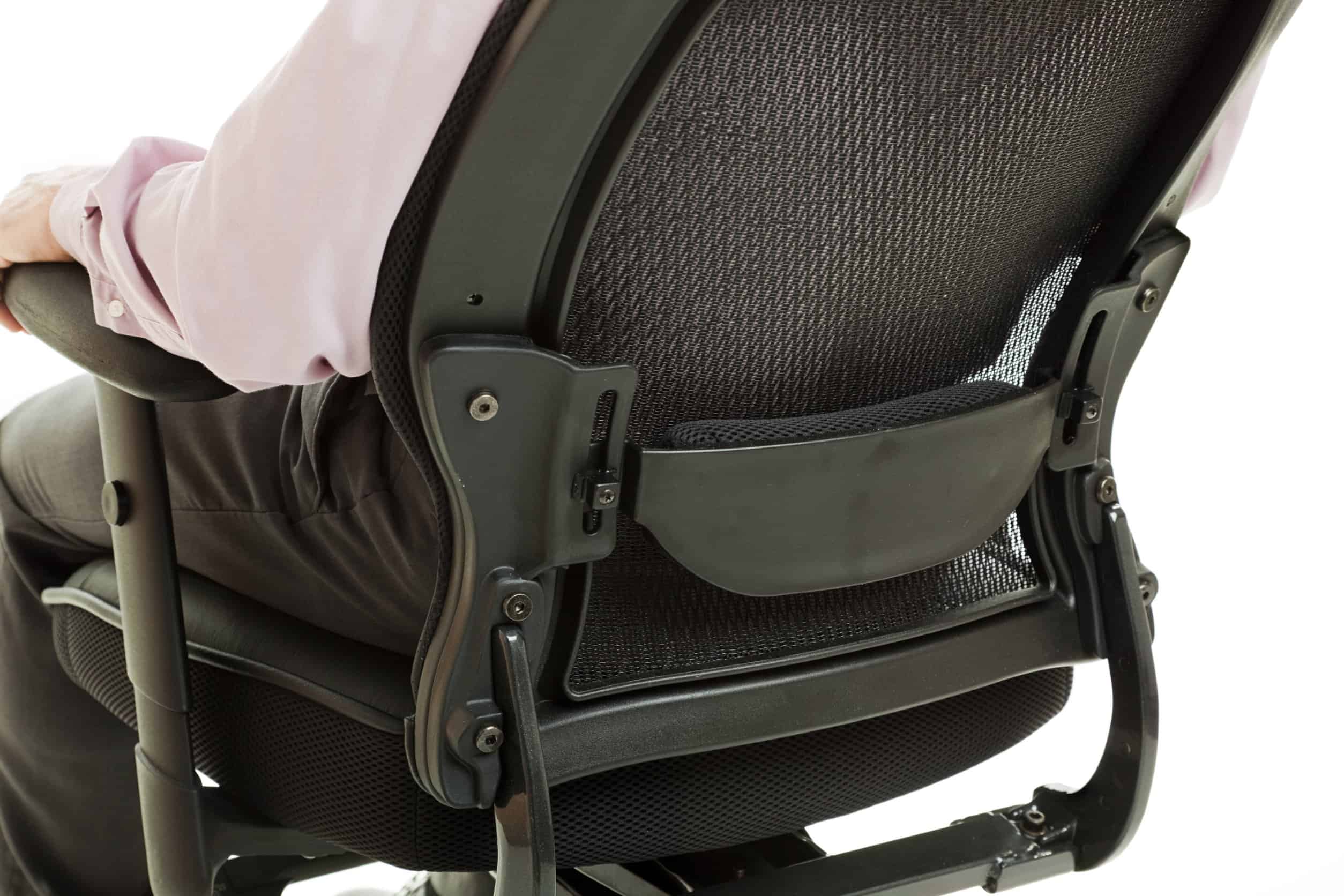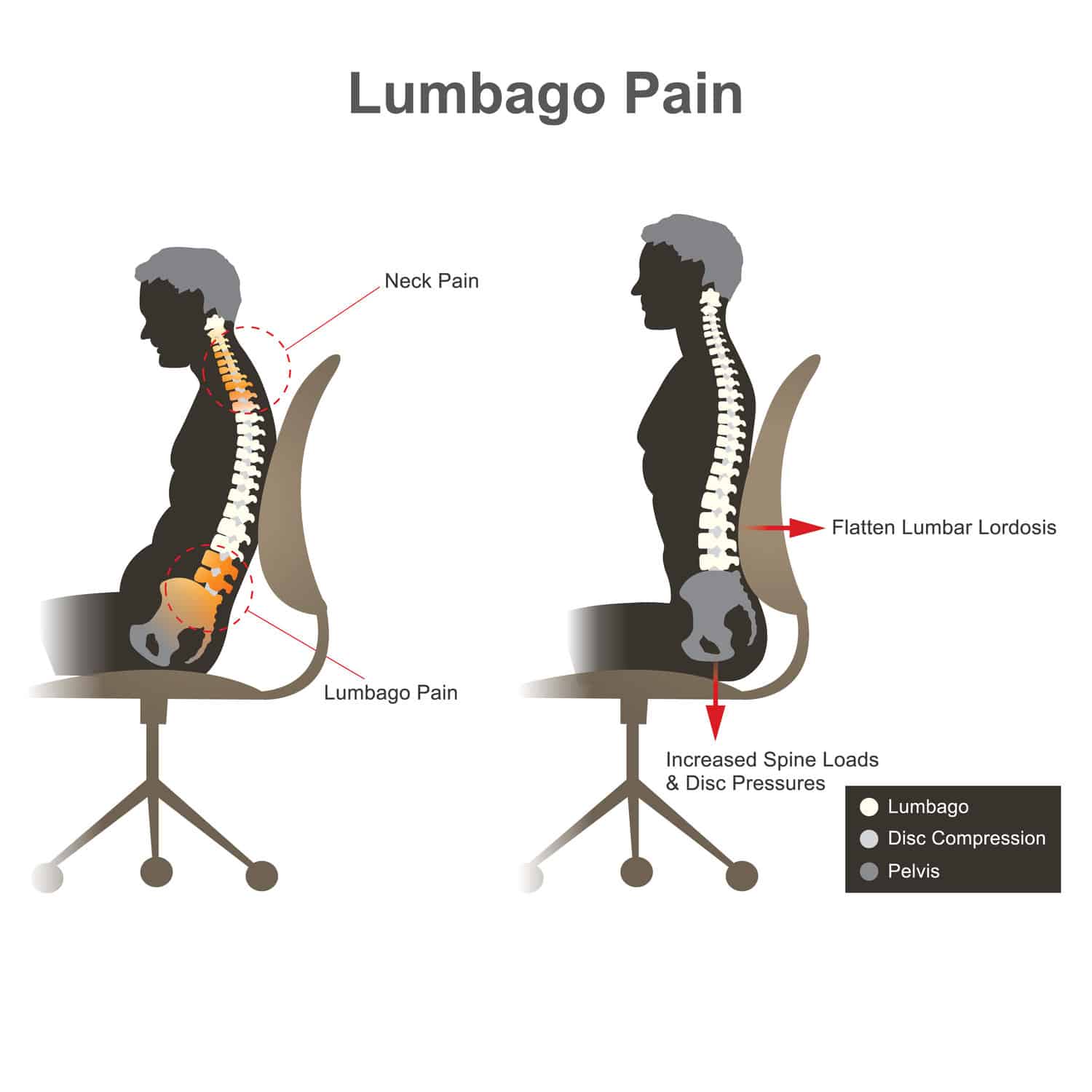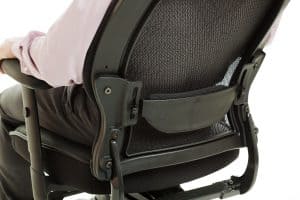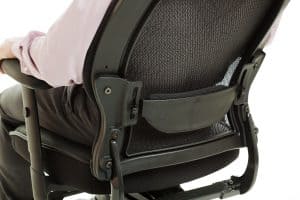Office chairs are like shoes – we spend way too much time in them, so they must be comfortable and support our posture. Sitting at a desk all day can cause back and neck problems, and impact your quality of life.
Thankfully, furniture makers and designers came up with a solution.. By consulting specialists in orthopedic and vascular medicine and asking “What does the body need?”, instead of what looks good, they began to make chairs for efficiency and comfort in the workplace, not aesthetics.
These days we can enjoy ergonomic office chairs with lumbar support to sit comfortably. If you don’t know what lumbar support is, grab your seat and hold tight as we explain this piece of ergonomic revolution.

The Invention of Lumbar Support
The concept of ergonomics was popularized around the 1950s and 60s, although it wasn’t until 1994 when the true revolution of office chairs began with the use of the lumbar support.
The introduction of lumbar support is one of the biggest milestones and a true game-changer in the history of office chairs. In fact, the first office chair using lumbar support is probably the only one that people know by name – the Aeron Chair designed by William Stumpf and Donald Chadwick for Herman Miller. Today, the Aeron chair is still one of the best-selling office chairs on the planet.
But, why was lumbar support such an important invention when it comes to chairs? Let’s see.
What Is Lumbar Support and How It Works?
To truly understand what lumbar support is, we briefly need to turn to biology and explain how our body works. Let’s start with the term “lumbar.”
The Lumbar Spine
Lumbar is a term used to describe a portion of your spine, located in your lower back. Overall, the spine has four sections: cervical spine (neck spine), thoracic spine (upper back), lumbar spine (lower back), and sacral region (bottom of the spine). Each section is associated with distinct functions, and therefore, distinct back problems.
The lumbar spine is the largest vertebrae of your entire spine and it’s located just below your chest (thoracic region), and above your pelvic bone. Its role consists of supporting and stabilizing your upper body, allowing truncal movements, and controlling movements in the leg.

On the image on the right you can see the lumbar spine marked with red. The most important thing to note here is the curvature of the spine. The lumbar region of the spine has a slight inward curve, which is a normal part of the spine’s structure.
The spinal curves help to evenly distribute stress and pressure among each individual vertebrae (interlocking bone in the spinal column) while the body is resting or moving. This is incredibly beneficial because if there’s too much pressure on one or a few vertebrae, a disk may tear or break and you might end up with a herniated disk, among other frequent back problems.
Back problems can occur in both cases – when the natural curvature of the spine is too intense or when it’s too flatten (straight back). And, studies have found that prolonged sitting, such as when you have a desk job, decreases the natural curve of the lumbar spine. In other words, it flattens it and that causes a lot of problems.
How Sitting Affects The Lumbar Spine?
There’s a big pile of evidence that shows sitting for prolonged periods of time increases stress on the lumbar spinal structure and back muscles, overstretches the spinal ligaments, and strains the spinal discs. The end-result is repeating episodes of intense back pain.
But, why is sitting so bad? Because it hurts the natural curve of your spine.
Think about it, how is the position of the spine different when we stand and when we sit? The most noticeable difference between the two positions is the elongation of the lumbar spine. You can see this clearly on the image illustrating lumbago – pain originating in the lower back – a condition that affects nearly 80% of the Western world population.

Laying down with the spine in its natural position creates the least pressure on the vertebrae. Standing already increases the pressure by 4 times when compared to laying down. Furthermore, sitting adds an additional 50% more pressure when compared to standing, or 6 times more pressure than when lying down.
Finally, sitting with your weight put forward, like when you lean toward your computer, creates the most stress and pressure on your lumbar spine, resulting in many common lower back problems today.
What can you do to prevent lower back pain?
The Invention of Lumbar Support
To tie the story together, we need to explain the concept of support within the lumbar support phrase.
Now that we know how our lumbar spine looks and how sitting affects its structure, we can better understand the need for an ergonomic chair design that will support our natural spine curves. And, in a nutshell, this is what lumbar support is all about.
Inspired by the growing body of knowledge in medicine and more specifically, orthopedic, in 1994, William Stumpf and Donald Chadwick developed a chair that had a molded pad into the curvature of the backrest – meant to follow and support the natural curve of the lumbar spine. It came in three sizes to match the chair’s design to people’s natural spine structure.
Needless to say, this move changed the history of the office chairs and redefined how we view workspace ergonomics and aesthetics.
Today, lumbar support is an essential aspect of almost every office chair design. It can be built-in or come as a separate attachment. However, not everyone is that enthusiastic about chairs with lumbar support. Some people find them uncomfortable or hate the aesthetics of chairs with lumbar support. This brings us to the question of how important lumbar support is and whether it’s truly necessary.
Is Lumbar Support Necessary?
The short answer is yes, lumbar support in chairs is absolutely necessary. The long answer depends on several considerations including time spent sitting, sitting habits, age, and many other factors.
However, most people can benefit from lumbar support regardless of individual differences.
If you’re an employer trying to decide what type of chairs to buy for the office, you’ll be interested to know that around 19.7% of workplace absences each year are due to musculoskeletal problems, such as back pain. This means that chairs with lumbar support means less work absences, fewer financial losses (indirect), and healthier and happier employees.
On the other hand, if you’re an individual looking to buy a gaming chair or a desk chair, you need to remember that prolonged sitting is considered the new smoking. It creates many problems including:
- weakening of the leg muscles;
- pressing on the nerves of the legs;
- shortening of the hip flexor muscles (problems with hip joints);
- compression and premature degeneration of spine disks;
- back and neck pains, and more.
Hopefully, these reasons are convincing enough to persuade you to invest in a chair with lumbar support.
How to Choose a Chair with Lumbar Support?
Some people find chairs with lumbar support uncomfortable. So, you might rightfully ask how to know whether chairs with lumbar support actually encourage proper posture and are good for your back.
First, let’s clear one thing – lumbar support should not feel too uncomfortable, unnatural, or painful. If that’s the case, then maybe the lumbar support pad or curvature is not in the right position for your back. In most office chairs, the lumbar support will be positioned at the bottom of the chair’s backrest. However, that may not be the best place depending on the chair size, and your back height. The best way to know that the lumbar support is in the right position is if you feel it slightly, just above your belt line.
Second, having lumbar support does not automatically mean that you’ll sit properly. Some people have bad sitting habits and they might still sit with slouched backs even with lumbar support. To prevent this, keep these things in mind:
- Sit at the back of the seat with the back rested on the backrest (with lumbar support).
- Sit upright with your shoulders moved back (do not slouch them forward).
- Your upper body weight should rest on the chair – do not lean forward.
- Keep your feet on the floor or slightly elevated on a stool.
- Your head, shoulders, and devices should be aligned into a straight line.
Finally, remember that at the beginning, sitting properly with lumbar support can be slightly uncomfortable. This is especially true if you have weak back muscles, or you’re very used to slouching. Suddenly keeping your back straight can make your back muscles sore – but, this is something that goes away after some time.


